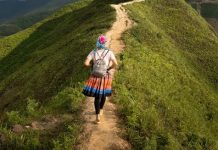Lace up your boots and get ready to explore the vast wilderness of Rocky Mountain National Park, where the windswept tundra contains an ecosystem of hundreds of species of wildflowers, and the sculpted peaks silhouetted against the blue sky serve as a dramatic reminder of the last ice age. It’s a big place, so to help you find your way, here are some of Rocky Mountain National Park’s best hikes.
Bear Lake
Bear Lake is one of the park’s most popular destinations for first-time visitors, and with good reason. From here you’ll have a front-row vantage point of the dramatic glacial valleys and hulking granite summits that make the Rocky Mountains such a singular landscape. With ten lakes in the area and superb vistas, you should definitely expect large crowds.
Hikes here range from easy jaunts around Bear Lake (0.5 miles) or to Alberta Falls (1.6 miles) to more challenging excursions that follow the glacial valleys up to their origins. Mills Lake (5.6 miles) is a good choice, as is the Loch (6.2 miles), which can be extended to the exquisite Lake of Glass and Sky Pond (9.8 miles), both of which are as serene as their names suggest. And while Flattop Mountain (12,324ft, 8.8 miles) may not be the park’s best summit, there’s no denying its magnetic pull from down below. Use the park shuttles to get to the trailhead.
Trailhead: Bear Lake/Glacier Gorge
Difficulty: Easy to strenuous
Total Distance: .8 miles
Elevation Gain: 45ft
Great for: Aspen groves and a picturesque lake
Bear Lake to Fern Lake
This day hike is a ranger favorite and known for its diverse scenery. On this hike you’ll climb up to the treeline and an alpine lake before dropping back down through fields of scree and into a forested valley. Here you’ll pass more lakes, waterfalls, aspen groves and elk-inhabited meadows.
Thanks to the park shuttle system, this is a one-way trip that requires no backtracking – and what’s more, it’s mostly downhill. You can’t miss Lake Helene, which sits serenely beneath the imposing rough-cut cliffs of Notchtop and Flattop mountains. To do this hike, park at Fern Lake Trailhead (the endpoint), and then take the shuttle to Bear Lake Trailhead. Shorten the trip by simply going to Lake Helene and back (5.8 miles).
Trailhead: Bear Lake
Difficulty: Moderate
Total Distance: 9.2 miles
Elevation Gain: 1215ft
Great for: Great views and a mountain lake
 A bull elk bugles a challenger to a rival bull in Rocky Mountain National Park
A bull elk bugles a challenger to a rival bull in Rocky Mountain National Park
Longs Peak & Chasm Lake
Iconic in every way, Longs Peak is the pinnacle of RMNP and one of Colorado’s classic climbs. The tallest peak in the park (14,259ft), Longs Peak’s exhilarating and exhausting Keyhole Route is on many visitors’ to-do list. The top of this route is the crux, consisting of narrow traverses, vertiginous cliff faces and heart-pounding clambering up polished slabs of rock. Most people start the climb by 3am in order to reach the summit before noon.
The good news is that you don’t have to reach the summit or turn your legs to jelly. Chasm Lake, located at the foot of the Diamond – Longs’ legendary east face where technical climbers rope up to scale the 1000ft wall – is routinely rated as one of the park’s best hikes. Chasm features all the spectacular scenery of the peak without the risk and arduous ascent. However, at 8.4 miles round trip, you’ll still need to be in very good shape.
Trailhead: Longs Peak
Difficulty: Very Strenuous
Total Distance: 15 miles
Elevation Gain: 5100ft
Great for: A difficult but rewarding hike with spectacular views
Gem Lake
At the northeastern end of the park is Lumpy Ridge, composed of 1.8-billion-year-old granite formations that were sculpted by the elements rather than by glaciers. This markedly different style of erosion has resulted in an array of whimsically shaped boulders, balancing rocks and colossal domes. The trail to Gem Lake is a great way to explore the area, with superb vistas back to the Continental Divide all the way up to the jewel-like lake.
Kids love the abundant scrambling opportunities in this area (as do rock climbers), making it a good family hike. While relatively short, the elevation gain will keep you puffing.
Trailhead: Lumpy Ridge
Difficulty: Moderate
Total Distance: 3.6 miles
Elevation Gain: 910ft
Great for: Active families and unique landscapes
 Area history is seen throughout Rocky Mountain National Park, such as in this log cabin at Holzwarth Historic Site
Area history is seen throughout Rocky Mountain National Park, such as in this log cabin at Holzwarth Historic Site
Mount Ida
One of the easier peaks to access along the Continental Divide, Mt Ida (12,880ft) is a choice spot to enjoy a prolonged top-of-the-world feeling and monumental views in all directions. Perhaps because it is on the western side of the park, this is a relatively unknown summit and an excellent place to escape the crowds along Trail Ridge Road. Indeed, most of the drivers across the valley will be craning their necks in admiration of the ridge you’re about to ascend.
This is a relatively gradual ascent, following the Continental Divide Trail past miniature alpine wildflowers (whose roots extend six feet below ground) all the way to the summit. The last stretch is a clamber through boulder fields and past a few false peaks – the reward is soon to come, with a sheer drop-off on the eastern side of the ridge that looks down upon a string of icy-blue alpine lakes.
Trailhead: Milner Pass
Difficulty: Moderate to Strenuous
Total Distance: 10 miles
Elevation Gain: 2122ft
Great for: Sweeping views and challenging ascents
Tips & Safety
- These hikes are best done from mid-June to mid-October. Be prepared for snow and ice the rest of the year.
- Get an early start – dawn if possible – as this will not only improve your chances of spotting wildlife, but also ensure you get a coveted parking spot and are out of the high country by noon, when summer storms usually roll in.
- Don’t underestimate the altitude, especially if you’re coming from sea level. Give yourself time to acclimatize and bring sunscreen, sunglasses, hat, ibuprofen, windbreaker and fleece. Staying hydrated is crucial.
- The park has six developed campsites. The best camping options, however, are in the backcountry, where you’ll find over 200 sites and greater seclusion. Hiking from Wild Basin Trailhead to Ouzel Falls and then Bluebird or Thunder Lake makes for an unforgettable backpacking trip.
This article was originally published in October 2014. It was updated in 19 August 2019.




